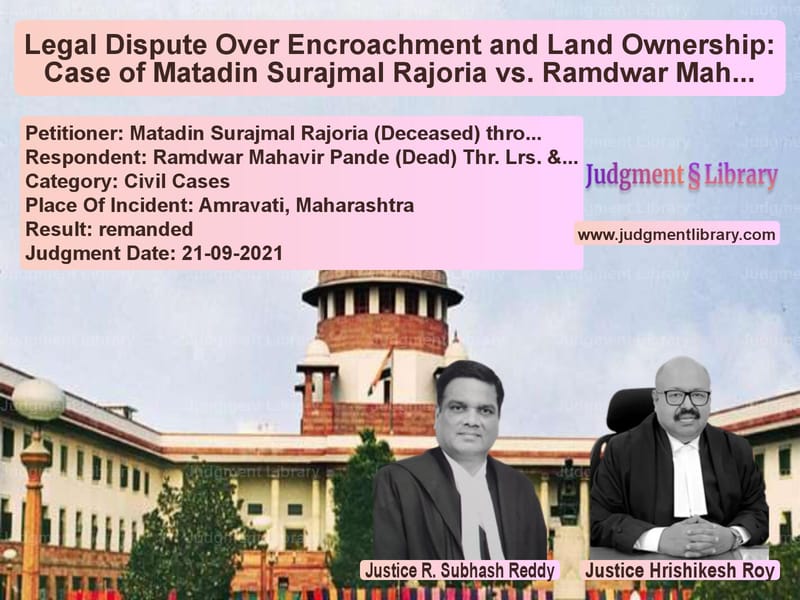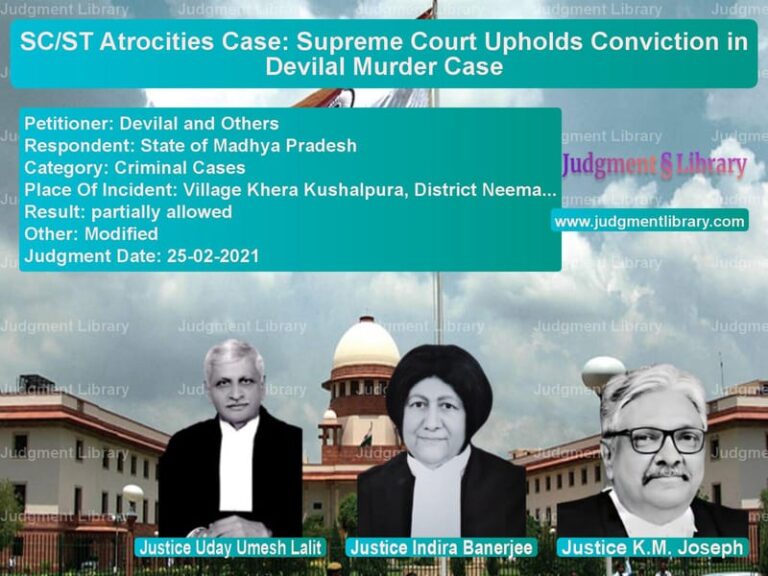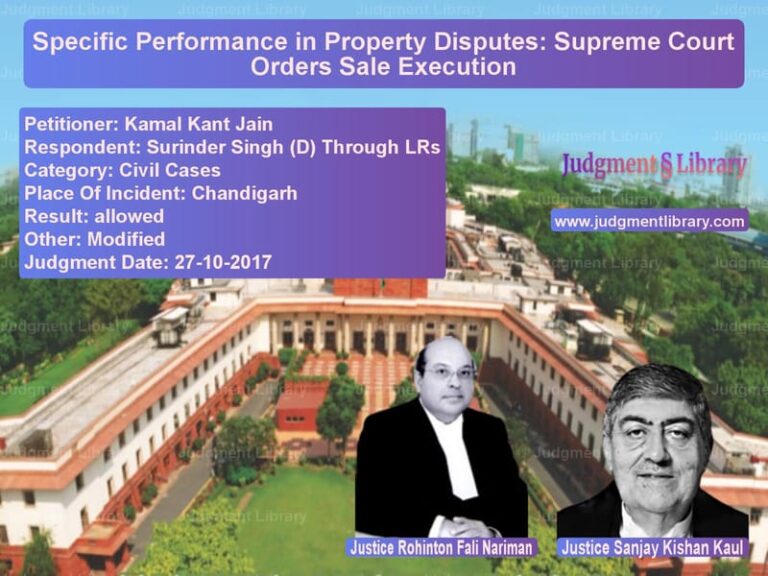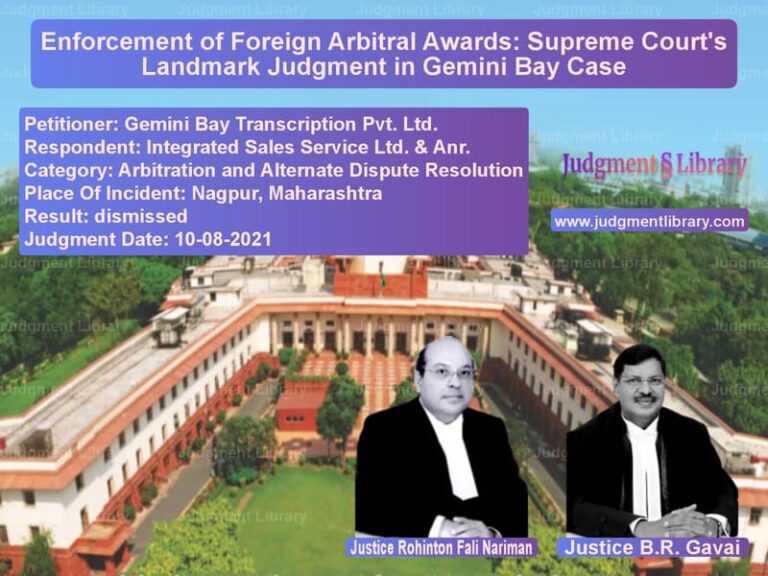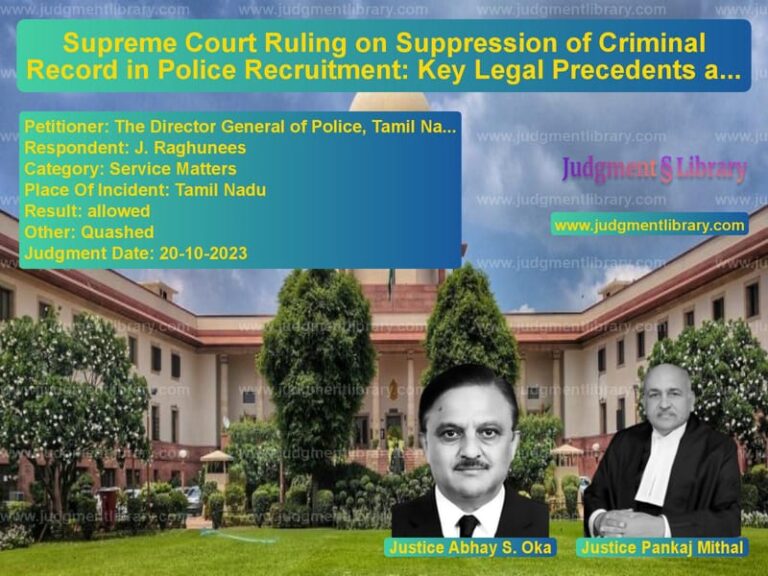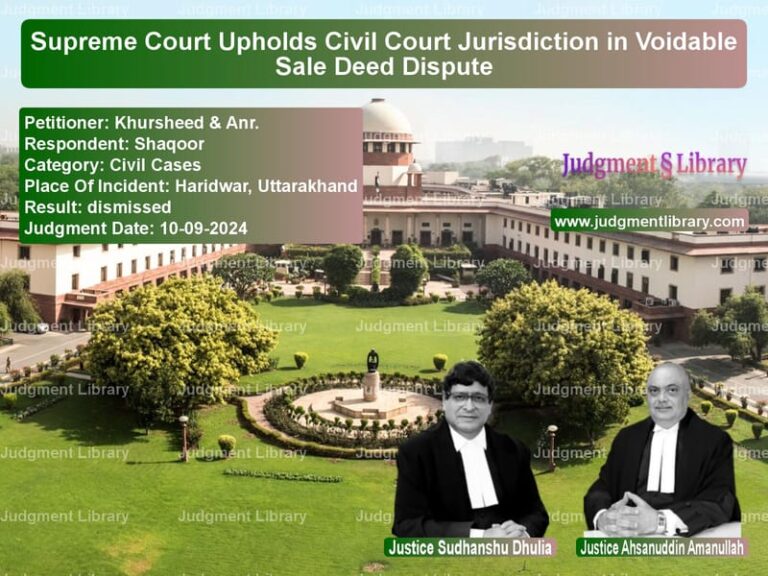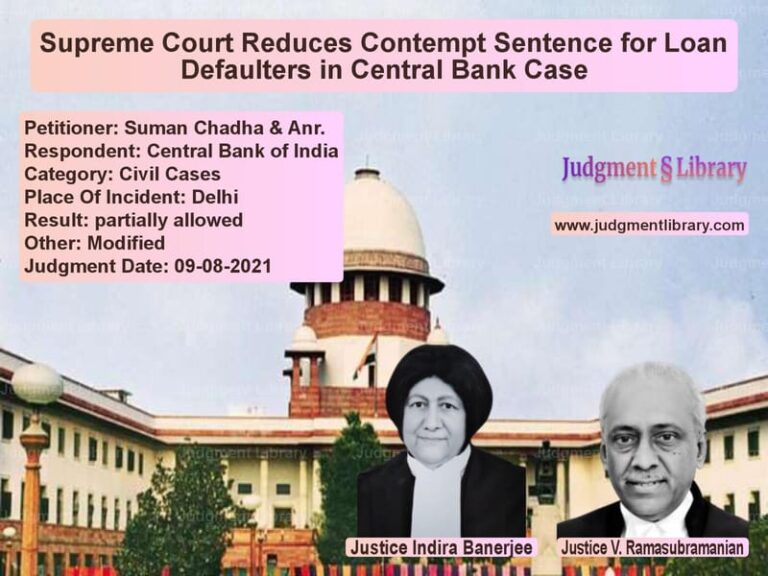Legal Dispute Over Encroachment and Land Ownership: Case of Matadin Surajmal Rajoria vs. Ramdwar Mahavir Pande & Ors.
This case revolves around a legal dispute regarding encroachment and land ownership between Matadin Surajmal Rajoria (the appellant) and Ramdwar Mahavir Pande & Ors. (the respondents). The appellant, who purchased land in 1995, filed a civil suit in 2003 alleging encroachment by the defendants on the purchased land. The suit sought to declare the encroachment as illegal and sought possession of the encroached land.
Background of the Case:
The appellant purchased a piece of land (1 Hectre 62 Acres) within the municipal limits of Amravati for Rs. 2,10,000 on December 28, 1995. According to the sale deed, portions of the purchased land were encroached upon by Ramdwar Mahavir Pande and Sudamadevi Pande (defendants). In 2002, the appellant discovered the encroachment when he measured the land and found that the defendants had occupied 35 R and 3 R of land respectively. Despite multiple requests, the defendants refused to remove the encroachments, leading to the appellant filing a civil suit for declaration, injunction, and possession.
Petitioner’s Arguments:
The appellant’s counsel argued that the defendants had encroached on the land and that their continued occupation of the land was illegal. The sale deed of 1995 (Exhibit 47) explicitly mentioned the encroached areas, and the appellant’s survey of the land in 2002 confirmed the encroachment. The appellant’s counsel further contended that the defendants’ claims based on their respective sale deeds (Exhibits 66 and Art.A) were invalid since the areas they occupied were much larger than what was stated in the deeds.
Respondent’s Arguments:
The respondents, on the other hand, claimed ownership over the encroached land based on their respective sale deeds executed in 1969 and 1977. They argued that the appellant was aware of the encroachments when he purchased the land in 1995, and that the defendants had been in possession of the land for decades. The defendants also pointed out that a previous suit filed by M/s Edulji Dotimal Ginning and Pressing Factory Ltd. in 1979 against Ramdwar Mahavir Pande regarding encroachment had been dismissed, further establishing their legal right to the land.
Trial Court’s Judgment:
The trial court dismissed the appellant’s suit, citing a lack of evidence proving the encroachment. The court noted that the appellant was aware of the encroachment at the time of purchase, and that the defendants had been in possession of the land since the 1960s. The court also pointed out that the appellant failed to provide a map or sketch to support his claims of encroachment. The trial court concluded that the defendants were not encroachers but had occupied the land with permission from the appellant’s predecessor in title.
Appellate Court’s Decision:
The appellate court upheld the trial court’s decision, stating that the defendants were in continuous possession of the disputed land with the knowledge and permission of the appellant’s predecessor. The appellate court found no merit in the appellant’s claims of encroachment, emphasizing the longstanding occupation of the land by the defendants and the lack of sufficient evidence to prove the encroachment.
High Court’s Findings:
The High Court, while reviewing the second appeal, decided to appoint a court commissioner to carry out a joint measurement of the disputed land. The surveyor, appointed by the court, found that the defendants had encroached upon 38 R (40,888 square feet) of the land. The court took this surveyor’s report into account and concluded that the defendants had indeed encroached on the land owned by the appellant. However, the High Court upheld the lower courts’ decisions, stating that the plaintiff’s sale deed had been clear about the defendants’ possession of the disputed land, and therefore the encroachment claims could not be upheld.
Important Verbal Arguments by the Court:
The most significant arguments presented by the court revolved around the claim of encroachment and the legitimacy of the defendants’ possession of the land. The court emphasized that while the defendants were indeed in possession of the land, the appellant had failed to provide sufficient evidence to prove the encroachment. The court also noted that the defendants’ claim of ownership was supported by valid sale deeds, and the lack of a clear map or sketch by the appellant weakened his case. The High Court also underscored the longstanding possession of the land by the defendants, which had not been disputed until the appellant initiated the legal proceedings in 2003.
Conclusion and Remand:
Ultimately, the Supreme Court found that the High Court had failed to address the substantial question of law regarding the validity of the defendants’ claims and the appellant’s rights to the land. The Court ruled that the matter should be remanded to the High Court for reconsideration. Specifically, the High Court was asked to provide a ruling on the substantial question of law concerning the court-appointed surveyor’s findings, the discrepancy in the defendants’ claims of ownership, and the legal implications of the sale deeds presented by both parties. The Supreme Court also emphasized the need for the High Court to render a fresh finding, given the complexity of the dispute and the significant evidence presented during the proceedings.
Key Verbal Arguments by the Court:
The Court’s judgment included several key verbal arguments, particularly regarding the legal standing of the defendants’ claims and the failure of the appellant to substantiate his claims of encroachment. The Court stressed the importance of a thorough review of the surveyor’s report and the need for the High Court to independently assess the claims of both parties in light of the evidence. The Court’s decision to remand the case highlighted the necessity for a more detailed examination of the legal aspects involved in the dispute, including the validity of the sale deeds and the question of ownership.
Conclusion:
In conclusion, the Supreme Court allowed the appeal, remanding the case back to the High Court for further consideration. The Court directed the High Court to take into account the findings of the court-appointed surveyor and to render a decision on the substantial question of law. The Court emphasized the need for a fair and just resolution of the dispute, taking into account the complex facts of the case and the legal rights of the parties involved.
Petitioner Name: Matadin Surajmal Rajoria (Deceased) through Sole Legatee Lalita Satyanarayan Khandelawal.Respondent Name: Ramdwar Mahavir Pande (Dead) Thr. Lrs. & Ors..Judgment By: Justice R. Subhash Reddy, Justice Hrishikesh Roy.Place Of Incident: Amravati, Maharashtra.Judgment Date: 21-09-2021.
Don’t miss out on the full details! Download the complete judgment in PDF format below and gain valuable insights instantly!
Download Judgment: matadin-surajmal-raj-vs-ramdwar-mahavir-pand-supreme-court-of-india-judgment-dated-21-09-2021.pdf
Directly Download Judgment: Directly download this Judgment
See all petitions in Contract Disputes
See all petitions in Property Disputes
See all petitions in Damages and Compensation
See all petitions in Landlord-Tenant Disputes
See all petitions in Environmental Cases
See all petitions in Judgment by R. Subhash Reddy
See all petitions in Judgment by Hrishikesh Roy
See all petitions in Remanded
See all petitions in supreme court of India judgments September 2021
See all petitions in 2021 judgments
See all posts in Civil Cases Category
See all allowed petitions in Civil Cases Category
See all Dismissed petitions in Civil Cases Category
See all partially allowed petitions in Civil Cases Category

